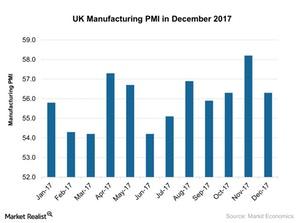What UK Manufacturing Activity Indicates for the Economy
UK manufacturing activity in December Between November and December 2017, the UK manufacturing PMI (purchasing managers’ index) fell to 56.3 from 58.2 and missed the market expectation of 58. The index was mainly affected by the following: production output and volume improved at a slower rate new and export orders rose at a slower pace employment in the manufacturing sector slowed In […]
Jan. 12 2018, Updated 7:34 a.m. ET

UK manufacturing activity in December
Between November and December 2017, the UK manufacturing PMI (purchasing managers’ index) fell to 56.3 from 58.2 and missed the market expectation of 58. The index was mainly affected by the following:
- production output and volume improved at a slower rate
- new and export orders rose at a slower pace
- employment in the manufacturing sector slowed
In the past six months, the UK economy (UKX-INDEX) has improved strongly. In November 2017, improved GDP growth, lower unemployment, and rising inflation helped its central bank raise its interest rate for the first time in nearly a decade.
Between November and December 2017, manufacturing activity weakened, mainly due to slower domestic demand. However, client orders from Europe (VGK) (IEV), China (YINN), and the Middle East rose strongly.
Index and ETF performance
The iShares MSCI United Kingdom ETF (EWU), which tracks the United Kingdom’s economic performance, rose nearly 2.2% in December 2017. In the next part of this series, we’ll analyze US non-farm payroll data in December 2017.
